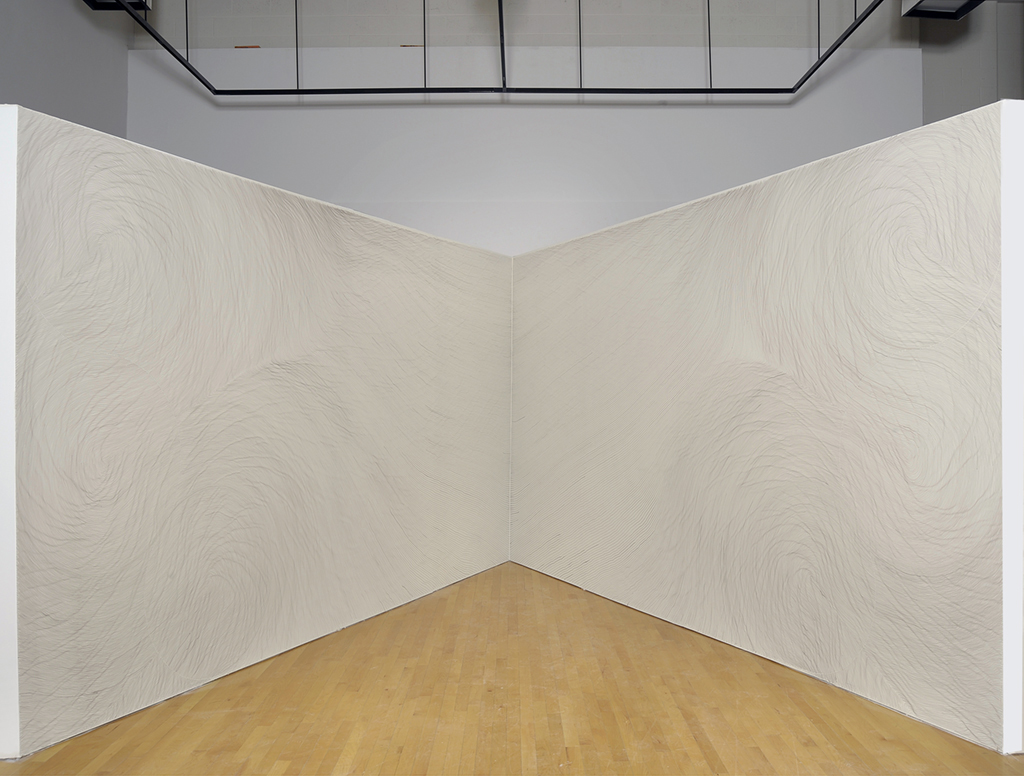EXHIBIT: Here Today @ Art Gallery of University of Maryland [ College Park, Maryland, US ] February 11 – March 13, 2009
Linn Meyers is the first participant in the artist-in-residence program at The Art Gallery. The Art Gallery launched an artist-in-residence program as an opportunity for artists to create site-specific installations and to give artists a space in which to imagine new ways to work. The residency is followed by an exhibition of the realized project and, in this instance, documented through time-lapse video and accompanied by a color brochure.
here today showcases two large-scale wall drawings by Linn Meyers. The wall drawings reflect a current trend occurring in her work in which the center of the image is filled with pulsating, curvilinear forms winding in a dramatic and moving pattern that reverberates out to the edges with fewer and more defined repeated lines. Visitors are immediately aware of transformation of the gallery space with the construction of a forty-four foot long concave wall covered by Meyers’ drawing, the artist’s largest wall drawing to date. The exhibition also features a number of smaller drawings on mylar, and what Meyers refers to as “preparatory drawings” created as part of the process leading up to the wall drawings.
The back gallery space features a unique first collaborative project between Meyers and sound artist Richard Chartier, in an installation where optical and sonic patterns intersect. With another architectural transformation of the gallery space, two fifteen foot long by eight foot high walls meet in an enfolding chevron, creating both a sound chamber and a drawing surface. The swirling lines of Meyers’ drawing, made directly on the surface of the walls, fuse together with the sound piece by Chartier, juxtaposing the organic and the digital into unified sensorial space. With eight audio transducers applied directly to the back surface of the walls, Chartier’s stark composition modulates and transfers through the surfaces.
Linn Meyers is an artist based in Washington D.C. Her art is featured in many collections throughout the country including: The Hirshhorn Museum and Sculpture Garden, Washington, DC; National Museum of Women in the Arts, Washington, DC; and the New Britain Museum of American Art, New Britain, CT. Her art has been featured in exhibitions at the Bus-dori Project Space and the Tokyo Metropolitan Museum of Art, in Tokyo, Japan; Gallery Joe in Philadelphia, PA; G Fine Art in Washington, DC; and Margaret Thatcher Projects in New York City. She received her BFA at The Cooper Union in New York and her MFA at the California College of the Arts in San Francisco.
Richard Chartier is a sound/installation artist based in Washington D.C. His minimalist sound works and installations have been presented internationally in exhibitions at museums and galleries including: the ICC (Intercommunication Center) in Tokyo, Japan; Castello di Rivoli in Torino, Italy; Whitney Museum of American Art in New York; The Art Institute of Chicago; and G Fine Art in Washington, DC. He has performed his works live throughout the world at festivals, museums and art spaces in Europe, Japan, Australia, and North America.
CATALOG: Featuring an interview with Linn Meyers by Jefferson Pinder, assistant professor in the Department of Art, and Lara Langer, Ph.D. student in the Department of Art History and Archaeology. Including full color illustrations of the two large wall drawings created in situ during Meyers artist-in-residence at The Art Gallery in January-February, 2009.
CD: a stereo composition based on the installation work will be released in March 2009 by the label Non Visual Objects (Austria) as a CD limited edition of 300.
ARTIST TALK: Linn Meyers & Richard Chartier, February 21, 2009
PHOTOS: Lee Stalsworth
